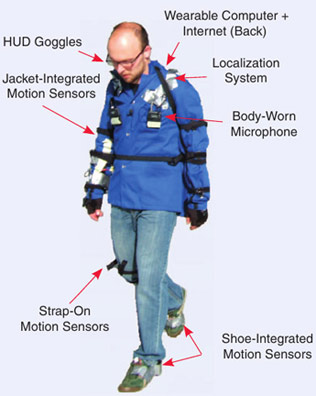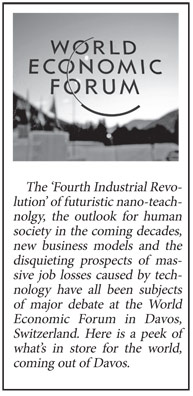A peek into futuristic tech revolution
There will be wearable internet, digital health
profiles to self-driving cars in the future:
by Fulvia Montresor
From intelligent robots and self-driving cars to gene editing and 3D
printing, dramatic technological change is happening at lightning speed.
The 'Fourth Industrial Revolution' is being driven by a staggering range
of new technologies that are blurring the boundaries between people, the
internet and the physical world. It's a convergence of the digital,
physical and biological spheres.
It's a transformation in the way we live, work and relate to one
another in the coming years, affecting entire industries and economies,
and even challenging our notion of what it means to be human.
|

Our future includes wearable internet. (lifesciences.ieee.org) |
 Between 1985 and 1989, the Cray-2 was the world's fastest computer.
It was roughly the size of a washing machine. Today, a smart watch has
twice its capabilities. Between 1985 and 1989, the Cray-2 was the world's fastest computer.
It was roughly the size of a washing machine. Today, a smart watch has
twice its capabilities.
As mobile devices become increasingly sophisticated, experts say it
won't be long before we are all carrying "supercomputers" in our
pockets. Meanwhile, the cost of data storage continues to fall, making
it possible keep expanding our digital footprints.
Today, 43% of the world's population is connected to the internet,
mostly in developed countries. The UN has set the goal of connecting all
the world's inhabitants to affordable internet by 2020. This will
increase access to information, education and global marketplaces, which
will empower many people to improve their living conditions and escape
poverty. Imagine a world where everyone is connected by mobile devices
with unprecedented processing power and storage capacity. If we can
achieve the goal of universal internet access and overcome other
barriers such as digital illiteracy, everybody could have access to
knowledge.
Big data
Each time you run a Google search, scan your passport, make an online
purchase or tweet, you are leaving a data trail behind that can be
analyzed and monetized.
Thanks to supercomputers and algorithms, we can make sense of massive
amounts of data in real time. Computers are already making decisions
based on this information, and in less than 10 years, computer
processors are expected to reach the processing power of the human
brain.
This means there's a good chance your job could be done by computers
in the coming decades. Two Oxford researchers, Carl Bendikt Frey and
Michael A Osborne, estimated that 47% of American jobs are at high risk
of automation. A survey done by the Society shows people expect
artificial intelligence machines to be part of a company's board of
directors by 2026.
Analyzing medical data collated from different populations and
demographics enables researchers to understand patterns and connections
in diseases and identify which conditions improve the effectiveness of
certain treatments and which don't.
Digital health
Big data will help to reduce costs and inefficiencies in healthcare
systems, improve access and quality of care, and make medicine more
personalized and precise.
In the future, we will all have very detailed digital medical
profiles, including information that we'd rather keep private.
Think of apps that track how much you eat, sleep and exercise and
being able to ask a doctor a question by simply tapping it into your
Smartphone.
3D printers will create not only cars, houses and other objects, but
also human tissue, bones and custom prosthetics. Patients would not have
to die waiting for organ donations if hospitals could bioprint them.
In fact, we may have already reached this stage: In 2014, doctors in
China gave a boy a 3D-printed spine implant, according to the journal
Popular Science.
The 3D printing market for healthcare is predicted to reach some
US$4.04 billion by 2018. According to a survey by the Global Agenda
Council on the Future of Software and Society, most people expect that
the first 3D printed liver will happen by 2025.
The survey also reveals that most people expect the first 3D printed
car will be in production by 2022.
Three-dimensional printing, which brings together computational
design, manufacturing, materials engineering and synthetic biology,
reduces the gap between makers and users and removes the limitations of
mass production.
Consumers can already design personalized products online.
The internet of things
Within the next decade, it is expected that more than a trillion
sensors will be connected to the internet.
If almost everything is connected, it will transform how we do
business and help us manage resources more efficiently and sustainably.
Connected sensors will be able to share information from their
environment and organize themselves to make our lives easier and safer.
By 2020 around 22% of the world's cars will be connected to the
internet (290 million vehicles) and by 2024, more than half of home
internet traffic will be used by appliances and devices. Home automation
is also happening fast.
Only a tiny fraction of the world's GDP (around 0.025%) is currently
held on blockchain, the shared database technology where transactions in
digital currencies such as the Bitcoin are made.
But this could be about to change, as banks, insurers and companies
race to work out how they can use the technology to cut costs.
A blockchain is essentially a network of computers that must all
approve a transaction before it can be verified and recorded.
Using cryptography to keep transactions secure, the technology
provides a decentralized digital ledger that anyone on the network can
see.
Some expect that in less than 10 years it will be used to collect
taxes. It will make it easier for immigrants to send money back to
countries where access to financial institutions is limited.
Wearable internet
Technology is getting increasingly personal. Computers are moving
from our desks, to our laps, to our pockets and soon they will be
integrated into our clothing.
By 2025, some 10% of people are expected to be wearing clothes
connected to the internet and the first implantable mobile phone is
expected to be sold. Implantable and wearable devices such as sports
shirts that provide real-time workout data by measuring sweat output,
heart rate and breathing intensity are changing our understanding of
what it means to be online and blurring the lines between the physical
and digital worlds.
The potential benefits are great, but so are the challenges.
These devices can provide immediate information about our health and
about what we see, or help locate missing children. Being able to
control devices with our brains would enable differently-abled people to
engage fully with the world. There would be exciting possibilities for
learning and new experiences.
But how would it affect our personal privacy, data security and our
personal relationships? In the future, will it ever be possible to be
offline anymore? - World Economic Forum
The writer is the Director of the World Economic Forum |

